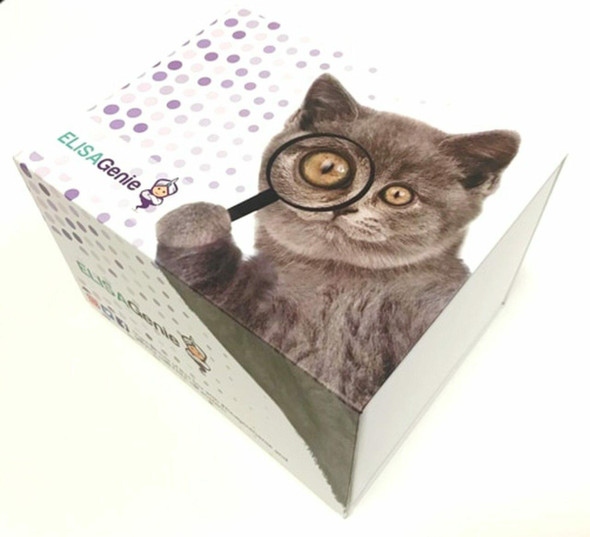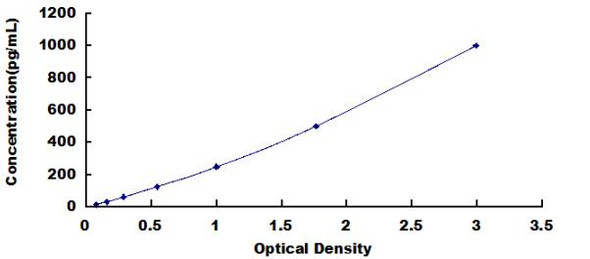Human EREG (Epiregulin) ELISA Kit (HUES01398)
- SKU:
- HUES01398
- Product Type:
- ELISA Kit
- Size:
- 96 Assays
- Uniprot:
- O14944
- Sensitivity:
- 9.38pg/mL
- Range:
- 15.63-1000pg/mL
- ELISA Type:
- Sandwich
- Synonyms:
- ER, EPR
- Reactivity:
- Human
- Sample Type:
- Serum, plasma and other biological fluids
- Research Area:
- Cardiovascular
Description
Human EREG (Epiregulin) ELISA Kit
The Human EREG (Epiregulin) ELISA Kit is specifically designed for the precise measurement of epiregulin levels in human serum, plasma, and cell culture supernatants. With exceptional sensitivity and specificity, this kit delivers dependable and consistent results, making it a valuable tool for various research purposes.Epiregulin is a key growth factor that plays a vital role in cell proliferation, differentiation, and tissue repair. Its involvement in various physiological and pathological processes, including cancer, inflammation, and wound healing, highlights its significance as a biomarker for studying these conditions and exploring potential therapeutic interventions.
Ideal for researchers and healthcare professionals alike, the Human EREG (Epiregulin) ELISA Kit offers a reliable and efficient solution for quantifying epiregulin levels, facilitating in-depth investigations and advancements in biomedical research.
| Assay type: | Sandwich |
| Format: | 96T |
| Assay time: | 4.5h |
| Reactivity: | Human |
| Detection Method: | Colormetric |
| Detection Range: | 15.63-1000 pg/mL |
| Sensitivity: | 9.38 pg/mL |
| Sample Volume Required Per Well: | 100µL |
| Sample Type: | Serum, plasma and other biological fluids |
| Specificity: | This kit recognizes Human EREG in samples. No significant cross-reactivity or interference between Human EREG and analogues was observed. |
This ELISA kit uses Sandwich-ELISA as the method. The micro ELISA plate provided in this kit has been pre-coated with an antibody specific to Human EREG. Standards or samples are added to the appropriate micro ELISA plate wells and combined with the specific antibody. Then a biotinylated detection antibody specific for Human EREG and Avidin-Horseradish Peroxidase (HRP) conjugate are added to each micro plate well successively and incubated. Free components are washed away. The substrate solution is added to each well. Only those wells that contain Human EREG, biotinylated detection antibody and Avidin-HRP conjugate will appear blue in color. The enzyme-substrate reaction is terminated by adding Stop Solution and the color turns yellow. The optical density (OD) is measured spectrophotometrically at a wavelength of 450 nm ± 2 nm. The OD value is proportional to the concentration of Human EREG. The concentration of Human EREG in samples can be calculated by comparing the OD of the samples to the standard curve.
| UniProt Protein Function: | Epiregulin: Ligand of the EGF receptor/EGFR and ERBB4. May be a mediator of localized cell proliferation. As a mitogen it may stimulate cell proliferation and/or angiogenesis. |
| UniProt Protein Details: | Protein type:Membrane protein, integral Chromosomal Location of Human Ortholog: 4q13. 3 Cellular Component: extracellular space; integral to plasma membrane; extracellular region Molecular Function:protein binding; growth factor activity; epidermal growth factor receptor binding Biological Process: response to peptide hormone stimulus; nerve growth factor receptor signaling pathway; wound healing; activation of MAPK activity; positive regulation of smooth muscle cell proliferation; positive regulation of interleukin-6 biosynthetic process; female meiosis; negative regulation of smooth muscle cell differentiation; negative regulation of cell proliferation; primary follicle stage, oogenesis; positive regulation of fibroblast proliferation; cell-cell signaling; positive regulation of epidermal growth factor receptor activity; positive regulation of cell proliferation; positive regulation of innate immune response; ovarian cumulus expansion; angiogenesis; negative regulation of epithelial cell proliferation; positive regulation of cytokine production; epidermal growth factor receptor signaling pathway; anatomical structure morphogenesis; fibroblast growth factor receptor signaling pathway; phosphoinositide-mediated signaling; positive regulation of mitosis; cytokine and chemokine mediated signaling pathway; positive regulation of cytokine biosynthetic process; luteinizing hormone signaling pathway; keratinocyte proliferation; oocyte maturation; keratinocyte differentiation; ovulation; organ morphogenesis; positive regulation of protein kinase activity; mRNA transcription; innate immune response; negative regulation of transcription, DNA-dependent; positive regulation of phosphorylation; positive regulation of DNA replication |
| NCBI Summary: | Epiregulin is a member of the epidermal growth factor family. Epiregulin can function as a ligand of EGFR (epidermal growth factor receptor), as well as a ligand of most members of the ERBB (v-erb-b2 oncogene homolog) family of tyrosine-kinase receptors. [provided by RefSeq, Jul 2008] |
| UniProt Code: | O14944 |
| NCBI GenInfo Identifier: | 8134446 |
| NCBI Gene ID: | 2069 |
| NCBI Accession: | O14944. 1 |
| UniProt Secondary Accession: | O14944,Q6FH69, B2RC66, |
| UniProt Related Accession: | O14944 |
| Molecular Weight: | 19,044 Da |
| NCBI Full Name: | Proepiregulin |
| NCBI Synonym Full Names: | epiregulin |
| NCBI Official Symbol: | EREG |
| NCBI Official Synonym Symbols: | ER |
| NCBI Protein Information: | proepiregulin |
| UniProt Protein Name: | Proepiregulin |
| Protein Family: | Proepiregulin |
| UniProt Gene Name: | EREG |
| UniProt Entry Name: | EREG_HUMAN |
As the OD values of the standard curve may vary according to the conditions of the actual assay performance (e. g. operator, pipetting technique, washing technique or temperature effects), the operator should establish a standard curve for each test. Typical standard curve and data is provided below for reference only.
| Concentration (pg/mL) | O.D | Average | Corrected |
| 1000 | 2.481 2.513 | 2.497 | 2.424 |
| 500 | 1.611 1.649 | 1.63 | 1.557 |
| 250 | 0.927 0.909 | 0.918 | 0.845 |
| 125 | 0.476 0.512 | 0.494 | 0.421 |
| 62.5 | 0.257 0.245 | 0.251 | 0.178 |
| 31.25 | 0.19 0.162 | 0.176 | 0.103 |
| 15.63 | 0.117 0.135 | 0.126 | 0.053 |
| 0 | 0.071 0.075 | 0.073 | -- |
Precision
Intra-assay Precision (Precision within an assay): 3 samples with low, mid range and high level Human EREG were tested 20 times on one plate, respectively.
Inter-assay Precision (Precision between assays): 3 samples with low, mid range and high level Human EREG were tested on 3 different plates, 20 replicates in each plate.
| Intra-assay Precision | Inter-assay Precision | |||||
| Sample | 1 | 2 | 3 | 1 | 2 | 3 |
| n | 20 | 20 | 20 | 20 | 20 | 20 |
| Mean (pg/mL) | 46.35 | 139.36 | 466.35 | 45.80 | 134.02 | 460.26 |
| Standard deviation | 2.96 | 7.61 | 20.38 | 3.14 | 7.48 | 15.92 |
| C V (%) | 6.39 | 5.46 | 4.37 | 6.86 | 5.58 | 3.46 |
Recovery
The recovery of Human EREG spiked at three different levels in samples throughout the range of the assay was evaluated in various matrices.
| Sample Type | Range (%) | Average Recovery (%) |
| Serum (n=5) | 92-106 | 100 |
| EDTA plasma (n=5) | 86-99 | 93 |
| Cell culture media (n=5) | 97-112 | 102 |
Linearity
Samples were spiked with high concentrations of Human EREG and diluted with Reference Standard & Sample Diluent to produce samples with values within the range of the assay.
| Serum (n=5) | EDTA plasma (n=5) | Cell culture media (n=5) | ||
| 1:2 | Range (%) | 96-112 | 89-105 | 88-103 |
| Average (%) | 103 | 96 | 95 | |
| 1:4 | Range (%) | 88-102 | 80-92 | 86-100 |
| Average (%) | 94 | 87 | 93 | |
| 1:8 | Range (%) | 91-106 | 84-97 | 86-101 |
| Average (%) | 98 | 90 | 93 | |
| 1:16 | Range (%) | 88-102 | 86-99 | 84-95 |
| Average (%) | 96 | 93 | 89 |
An unopened kit can be stored at 4°C for 1 month. If the kit is not used within 1 month, store the items separately according to the following conditions once the kit is received.
| Item | Specifications | Storage |
| Micro ELISA Plate(Dismountable) | 8 wells ×12 strips | -20°C, 6 months |
| Reference Standard | 2 vials | |
| Concentrated Biotinylated Detection Ab (100×) | 1 vial, 120 µL | |
| Concentrated HRP Conjugate (100×) | 1 vial, 120 µL | -20°C(shading light), 6 months |
| Reference Standard & Sample Diluent | 1 vial, 20 mL | 4°C, 6 months |
| Biotinylated Detection Ab Diluent | 1 vial, 14 mL | |
| HRP Conjugate Diluent | 1 vial, 14 mL | |
| Concentrated Wash Buffer (25×) | 1 vial, 30 mL | |
| Substrate Reagent | 1 vial, 10 mL | 4°C(shading light) |
| Stop Solution | 1 vial, 10 mL | 4°C |
| Plate Sealer | 5 pieces | |
| Product Description | 1 copy | |
| Certificate of Analysis | 1 copy |
- Set standard, test sample and control (zero) wells on the pre-coated plate and record theirpositions. It is recommended to measure each standard and sample in duplicate. Note: addall solutions to the bottom of the plate wells while avoiding contact with the well walls. Ensuresolutions do not foam when adding to the wells.
- Aliquot 100 µL of standard solutions into the standard wells.
- Add 100 µL of Sample / Standard dilution buffer into the control (zero) well.
- Add 100 µL of properly diluted sample (serum, plasma, tissue homogenates and otherbiological fluids) into test sample wells.
- Cover the plate with the sealer provided in the kit and incubate for 90 min at 37 °C.
- Aspirate the liquid from each well, do not wash. Immediately add 100 µL of BiotinylatedDetection Ab working solution to each well. Cover the plate with a plate seal and gently mix. Incubate for 1 hour at 37 °C.
- Aspirate or decant the solution from the plate and add 350 µL of wash buffer to each welland incubate for 1-2 minutes at room temperature. Aspirate the solution from each well andclap the plate on absorbent filter paper to dry. Repeat this process 3 times. Note: a microplatewasher can be used in this step and other wash steps.
- Add 100 µL of HRP Conjugate working solution to each well. Cover with a plate seal andincubate for 30 min at 37 °C.
- Aspirate or decant the solution from each well. Repeat the wash process for five times asconducted in step 7.
- Add 90 µL of Substrate Reagent to each well. Cover with a new plate seal and incubate forapproximately 15 min at 37 °C. Protect the plate from light. Note: the reaction time can beshortened or extended according to the actual color change, but not by more than 30min.
- Add 50 µL of Stop Solution to each well. Note: Adding the stop solution should be done inthe same order as the substrate solution.
- Determine the optical density (OD value) of each well immediately with a microplate readerset at 450 nm.









